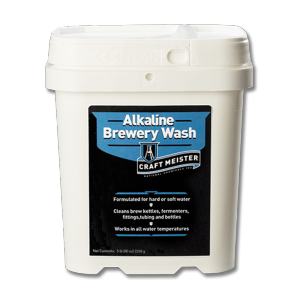It's a great word.
It just rolls off the tongue so easily
And if you want to easily clean the sludge and muck off your homebrew equipment, then alkaline brewery wash might just be the magic cleaning powder you are looking for.
Some brewers claim it works even better than PBW!
Some brewers claim it works even better than PBW!
The benefits of using alkaline wash include:
- Cleans effectively in cold or hot water
- Works longer than oxygen based cleaners as it doesn't break down the same way
- Can be used to remove troublesome bottle labels
- Does not leave a chalky residue as it reduces calcium carbonate and oxalate residues that oxygen based cleaners tend to leave behind
- Powdered formula will eat through carbon build-up
- Safe to come into contact with skin as it is non-caustic but we'd recommend you take precautions such as using safety gloves and avoiding getting it in your eye.
- It's safe on glass, plastic, and stainless steel but avoid using on aluminum as it will react with it
One of the most popular washes is the Craft Meister ABW, check out the price on Amazon.
How to use alkaline wash on brewing equipment
You can use it as a spray from a bottle or do a soak. Many brewers like to leave their equipment soaking overnight to ensure it really gets the job done.
It works on kegs and carboys, kettles with no issues.
Given the washes ability to dissolve organic matter, it works really well on bottles when you need to get rid of that sludge that gets left at the bottom - especially if you don't clean a few for a while and it dries out. 24 hours in an alkaline bath will sort them out, ready for bottling day.
It will also work wonders on your glass wear!
A user that brought this product online from Amazon said left this short but handy review:
"It seems a little better than PBW. I've used this to clean brewing equipment, as well as to soak and scrub etching marks from drinking glasses. A very effective cleaner."
How much wash do I use?
- For equipment like fermenters and bottles use 1 oz (2 scoops) per gallon of water.
- For heavier jobs like brew kettles use 2 oz (4 scoops) per gallon of water.
Is Craftmeister's Alkaline Brewing Wash better than PBW?
While both products are quite similar in their make up, there's some debate. Many brewers sweat it performs better than PBW, especially in cold water.
It's more expensive so you have to weigh it up - what's worth more to you time or cost savings? If you want to use a cheaper product, use a sodium percarboante laundry soak.
This quote from a forum sums things up nicely:
"Yes, it's pricey, but holy cow this stuff is magical. I've been pumping it around my rigs for years but you can't see the inside of a hex to appreciate how well caustics can work."Another committed user said:
"This cleaned spots in my glass carboys that PBW could never get rid of"So what are you waiting for? Check out the price on Amazon.
What are the active ingredients of Craftmeister's alkaline wash?
- Sodium Carbonate 50-65%
- Sodium Metasilicate 30-40%
- Sodium Sesquicarbonate ≤ 5%
On the safety certificate, National Chemicals (who produce the brand) state there are some other ingredients that are nonhazardous but are of a propriety nature so they do not disclose their full composition.
It's important to note that many other products out there are referred to alkaline wash powder for things like foot fungus and eczema. These products are made of different chemicals!
If you think the Craft Meister ABW might be for you, check out the price on Amazon.

0 comments:
Post a Comment